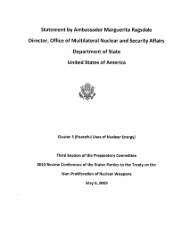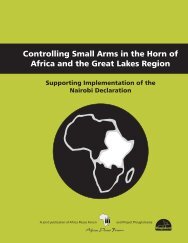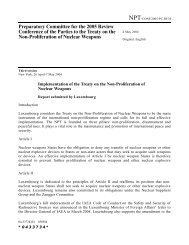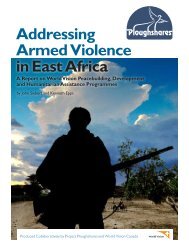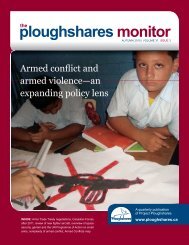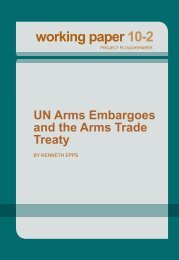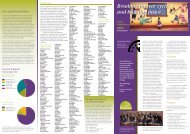Winter 2010 - Project Ploughshares
Winter 2010 - Project Ploughshares
Winter 2010 - Project Ploughshares
You also want an ePaper? Increase the reach of your titles
YUMPU automatically turns print PDFs into web optimized ePapers that Google loves.
The many faces of warAs the nature of conflict changes, traditional definitionsof warfare fall shortErnie RegehrBetween July 30 and August 4 thisyear, fighters of the DemocraticForces for the Liberation of Rwandaand elements of the Mai Mai, a localmilitia, entered Luvungi and surroundingvillages in the DemocraticRepublic of Congo (DRC) and, inone extended weekend, raped 150to 200 women and children, includinga number of baby boys. Theythen looted the area and moved on(Kaufman <strong>2010</strong>).News of the assaults did notreach international media outletsuntil weeks later, and when the UNthen investigated, it established thatthe number of rapes in the reportedincidents was actually 242. However,investigators also learned of another267 rapes in the district that had notbeen previously reported (Globe andMail <strong>2010</strong>).The context was the ongoing civilwar in the DRC, but somehow theterm “war” doesn’t come close to capturingthe scale of horror of Luvungi.The rapes are beyond extreme by anymeasure, but as part of the chaos andfighting that have engulfed the DRCsince 1990, the Luvungi victims representbut the tiniest fraction of thewar’s human toll. Five million deathsin the DRC are directly attributableto the war. Hundreds of thousandshave been raped; untold millions areinternally displaced. According toUNICEF, there are more than fourmillion orphaned children in the DRC. 1Contemporary war is largely “unofficial”and often unacknowledged. It israrely declared; flags and bugles don’therald its approach. The march to waris replaced by the gradual (or sometimesrapid) disintegration of order inseverely troubled societies and theinexorable descent into political andcriminal public violence.Indeed, “public violence” maywell be the more apt, though stillemotionally inadequate, term formany of today’s armed conflicts.Public violence is invariably linkedto longstanding social and politicalgrievances that remain chronicallyunaddressed and are allowed to festerand undermine confidence in publicinstitutions and processes. In turn,widespread rejection of public institutionsis transformed into lawlessnessand armed violence when ignoredgrievances are joined by a readyaccess to small arms – the pre-eminenthardware of public violence.When a state finds itself in thatdeadly combination of circumstances– pervasive grievance, loss of confidencein government, and abundantsupplies of user-friendly small arms –it finds it difficult to avoid the descentinto chaos and the public violencethat must finally be recognized as war.Counting the warsSince 1987 <strong>Project</strong> <strong>Ploughshares</strong>(<strong>2010</strong>a) has been tracking globalarmed conflicts and issuing annuallyan Armed Conflicts Report. In 1987,there were 37 wars taking place on theterritories of 34 states – Indonesia,the Philippines, and Iran were eachthe scene of two separate armed conflicts.Twenty-three years later, 2009ended with a total of 28 wars on theterritories of 24 countries – with thePhilippines and Sudan both the sceneof two separate wars, while Indianterritory hosted three armed conflicts.That is a welcome 25 per centdrop in the number of active armedconflicts, but it is a decline that masksa dynamic quarter-century of publicviolence and war in which many newwars began as others were ending.In addition to the 37 conflictsunder way in 1987, 44 new conflictsbroke out in the ensuing 23 years, fora total of 81 separate wars during thisperiod. Of those, 58 were resolved,but in 11 of those cases the peacedidn’t last and war resumed (of the11 resumed wars, six subsequentlyended). All told, the planet thushosted a total of 92 wars during thelast quarter-century.Not only do some conflicts reignite,but wars generally last a longtime. Fully one-third of the conflictsunder way in 1987 remain activetoday. Of the current 28 conflicts,only six are less than a decade old.Six have been under way for morethan three decades, another seven formore than two decades, and nine formore than one decade.A child pauses briefly with a toy in a camp forinternally displaced persons in Minova, DRC.© Aubrey Graham/IRIN.3The <strong>Ploughshares</strong> Monitor I <strong>Winter</strong> <strong>2010</strong>



